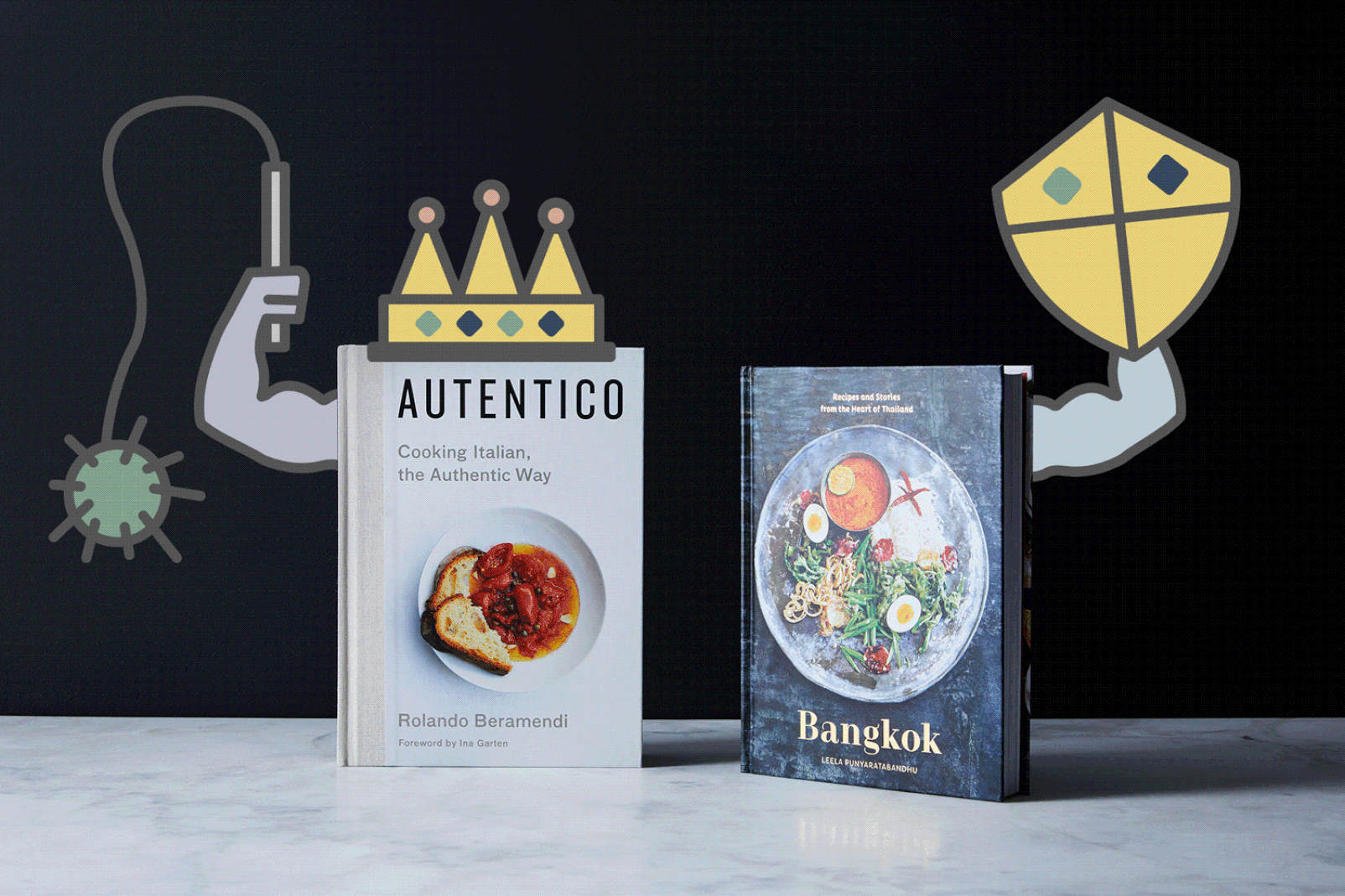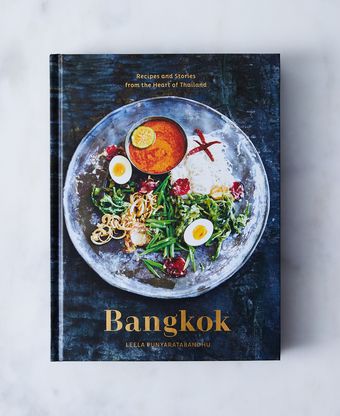Scene One: I am all thumbs, or rather, at least my thumbs actually work. Unlike my right index finger. That finger, wrapped up in a fancy splint, is useless. Stepping in, its neighbor—a heroic thumb—unlocks my phone. There’s an email from Piglet. It seems that I owe them something. Uh oh. It’s now four days before Christmas, and I have cooked precisely no dishes for the cookbook competition. The books have arrived, one Thai, one Italian. I have no excuses. Expletives. My finger, which remains a disconcerting gray-blue color, has been broken less than a month by a vengeful wooden 1970’s-era cheeseboard. I can barely tie my shoelaces. Still, I had promised to cook. And the cheeseboard must not be allowed to win.

Scene Two: Autentico by Rolando Beramendi. My love for Italy runs deep, a river stretching back 20 years. I’ve spent at least two weeks there every summer since the late 90s, when I joined the Slow Food Movement and helped the organization get going in the United States. Autentico: Cooking Italian, the Authentic Way is the full title and quite a claim, I think. I try to stave off a vague annoyance. (Doesn’t “Autentico” sound like an Italian-ish restaurant chain?). “I cook to break preconceived notions of what food should be—no overcrowded plates, no recipes with too many disparate ingredients, no out-of-season ingredients, no need for a lot of equipment,” the author’s introduction reads. The recipes seem to say differently, but no matter. His photo reveals a pleasant-looking fellow wearing an expensive-looking jacket while standing in a farmhouse stacked high with suspiciously photogenic monster truck tires. I sigh. “I’m sure he’s a very nice man,” I tell myself, and get cracking.
Staying away from dishes about which I have strong ideas, I select three: Agnello Dolce Forte (Sweet-and-Strong Lamb Stew), Risotto Verdissimo (The Greenest Risotto) and Tonno Alla Pantesca (Pantelleria-Style Slow-Braised Tuna). Photographed by Laurie Frankel, the book’s images are ravishing, and having written books myself, I’m jealous of the quality of the printing.
First up, the lamb. The recipe features shoulder meat bolstered by an array of herbs and spices and reminds me of Moroccan tagine. As I’m driving in downtown Brooklyn to load up on produce, a miraculous parking space opens up and boom, I’m in. Butcher, check. Supermarket, check. The famed Middle Eastern spice shops of Atlantic Avenue, check. And what trips me up? Can you believe candied orange peel? Dried mango, dried papaya, dried banana, dried coconut—entire sections of dried and candied fruit lay before me. No orange peel. I decide to candy the peel myself.
The instructions for the dish are short, solid, and pretty clear. It’s built on 3 cups of soffritto, a mirepoix-like mix of finely minced carrot, celery and onion cooked down in a sea of olive oil. As I move through the recipe, the house starts to smell good, and then fantastic. I decide that mashed potatoes sound like a better accompaniment than the rice, lentils or polenta recommended, so I cook both the potatoes and some rice, just in case. The stew, my guests agree, is brilliant—really delicious. Too much olive oil, perhaps, but I can forgive that. And he’s even right about the rice; it does work better. I’m impressed. All the flavors fall into place, the dish looks exactly like it does in the photo, and yes, as he claims, it is indeed even better two days later.
I love Thai food for sure, but the Thai book is in for trouble. One recipe down, five to go.
Scene Three: The sky, they say, is falling. Something they call a “bomb cyclone”, is about to descend upon New York City. It’s going to decimate us with 4 to 6 inches of sleet! It’s going to bury us under an 8-inch slab of ice! I’m unimpressed, but I also have an excuse to stay home on a Thursday.

Ambitiously titled simply Bangkok, the book opens with a highly evocative description of author Leela Punyaratabandhu’s upbringing in the eponymous city. I didn’t come here for the travelogue stuff, but she’s very engaging, and her filmic sense of scene is inspiring. David Loftus’ photos, which are also beautiful, look less composed than those in Beramendi’s pages—they seem like an invitation to a beautiful and colorful new world. I head into the recipes. Bangkok turns out to be awfully specific about ingredients. Duck eggs? “Young” galangal? Coriander roots? Sawtooth coriander? But I am not discouraged. I pick three dishes: Khai Phalo (Caramel-Braised Duck Eggs with Pork Belly), Tom Kha Kai Klan (Braised Chicken in Coconut-Galangal Cream Sauce), and Bami Tom Yam Kung Nam Khon (Creamy Tom Yam Noodle Soup with Shrimp).
Once again, I go shopping. Fortunately, there’s a tiny place in Chinatown in Manhattan called Bangkok Grocery Center and it’s reputed to have everything. The genial storeowner is enthusiastically helpful. His coriander has no roots (but the book says stems are acceptable), and I take whatever galangal he has, young or old, choosing the smoother looking knobs. He even has the sawtooth coriander, an elongated leaf with finely serrated edges. But there are no duck eggs.
Thursday morning, as predicted, the “bomb cyclone” attacks us with its wintery mix, and I get two Bowie albums going. I have all day, and I’m gonna do it, all three recipes. Punyaratabandhu’s instructions are colloquial and they’re both specific and loose at the same time—she tells you exactly how she wants it done, but thankfully also lets you off the hook or offers a substitution if you can’t get an ingredient. For example, fresh shrimp tomalley (which she knows perfectly well you can’t get) is “optional, but recommended” in the shrimp dish. You can swap evaporated milk for coconut milk—plenty of Bangkokians apparently do (I go for a blend).
The most intriguing cooking method of the day involves the braised chicken. In Thailand, the dish translates to “chicken [cooked] underneath water,” “three-water chicken,” or even “distilled chicken.” This involves cooking it in a Dutch oven under very low heat, a barely visible ring of flame, with a chamber full of ice serving as the lid for your pot. The aromatic steam from the pot rises up, condenses on the cold surface, and falls back onto the chicken. If the chicken itself isn’t “distilled,” some of the braising liquid certainly is. When all your ice has melted three times, you’re done, hence “three-water chicken.”
After about 90 minutes, I run out of ice. Thankfully, the “bomb cyclone” provides. I transfer the snow into a heavy African cast iron-bottomed pot and keep going. The chicken, despite my doubts, is a marvel. It falls off the bone and is ludicrously juicy and aromatic. The shrimp noodle soup is suitably fiery and reminiscent of great Thai meals I’ve had. And finally, the caramelized (chicken) egg with pork belly turns out to be truly one of the better dishes I’ve ever cooked. I’ve always wondered how to get that sort of flavor from working with palm sugar (it’s all about balance between sweetness, sourness, funk, and salt), and now mastery seems mine. As instructed by Punyaratabandhu, I eat the leftovers the next day for lunch, at my desk at the brewery. My colleagues are jealous. Now I’m getting smug. Four recipes down, two to go.
Scene Four: Back to Autentico, and please now receive my sad confession: This will be my first time preparing risotto. It will start with a “cracking” of the rice in olive oil over high heat before stirring in the broth—the broth I will make by stewing kale, parsley, leeks and “leftover greens,” which I have interpreted as “organic garden mix salad” (red oak leaves picked out). The broth turns out only mildly green and I wonder why it’s not greener. I start stirring, paying close attention to the instructions, but they’re not quite explicit enough. Beramendi leaves me guessing on some key details, like the tooth of the rice and how creamy it ought to be. Even after I add the necessary kale, it’s not that green. It looks like risotto with a lot of spinach in its teeth. There’s no picture, so I can’t be sure. But it’s certainly not the “greenest.” Optics aside, the risotto is good. Is it the best? No. It’s merely “nice.”

Beramendi neglects key details in the recipe for Tonno Alla Pantesca (Pantelleria-style slow-braised tuna), too. I read it five times, looking for a temperature for the oven. The author gives none. He simply instructs, “bake for 20 minutes,” and then “bake, uncovered, until the sides of the pan have a nice, almost burnt crust and the tuna is cooked through, about 10 minutes.” That’s 30 minutes altogether, and the tuna is only, as I was instructed, an inch thick. I notice the picture does not appear to show “an almost burnt crust.” Suspicious, I settle on a “medium” temperature of 350° F and hope it won’t be too high. The sauce itself is good—reminiscent of a sharp puttanesca, but I realize it‘s never going to completely cover the fish like it’s supposed to. My tuna is dry, and it’s hard to see how it wasn’t going to turn out that way. Have you ever over-cooked a tuna steak? Like for 30 minutes? Well, there you go.
I do love Italy. I’ve never been to Thailand, though it’s at the top of my list. I’m sure the author of Autentico is a good guy. I want his jacket and bits of his life. I’ll definitely cook his lamb stew again. But the author of Bangkok is more fun to hang out with; her descriptions of life in that city are like paintings; she isn’t judging me; her recipes work and the food was totally slammin’. Next time, I’ll find the damn duck eggs.
It’s Bangkok.



31 Comments
For duck eggs, check out the Duck Lady at George's Meat Market, NW corner Eldridge and Grand.
She has the best cooked ducks in the city and always has trays of duck eggs available.
Keep on keepin' on...!
It kinda sucks though, because I had a lot arguments to persuade myself into getting another italian cooking book, and now I kinda don't anymore...*sigh*
(By the way, your review was very enjoyable to read. Nice work.)
Bangkok in the lineup didn’t interest me at all. Except for the inauthentic-but-delicious Thai Chicken Curry in The Frog Commissary Cookbook, in which (seriously) béchamel sauce is used instead of coconut milk, I don’t make Thai food at home. The person I eat dinner with doesn’t like it. He can’t stand coconut milk because he hates the way it tastes, and he can’t stand fish sauce because he hates the way it smells. I can sneak fish sauce into dishes; it can add excellent umami essence and in a dish does not taste the way it smells. But I can’t get away with that with coconut milk. Therefore, I am VERY INTERESTED in the comment in this review that says Bangkokians use evaporated milk in place of coconut milk. Did I read that right? Can I do that all – or most - of the time? Help me out here.
I liked this review and was persuaded by the result. I thought at the end of it I would want to go ahead and get Authentico, but instead I’m interested in Bangkok (especially if the evaporated milk thing is correct).
And that’s why I love The Piglet.